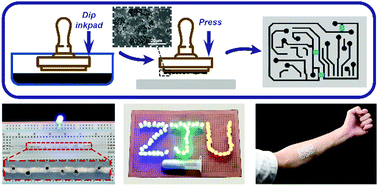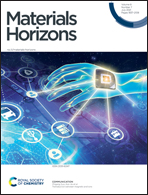Recyclable conductive nanoclay for direct in situ printing flexible electronics†
Abstract
Liquid-metal (LM)-based flexible and stretchable electronics have attracted widespread interest in wearable health monitoring, electronic skins, and soft robotics. However, it is challenging to directly pattern LMs on soft substrates to form desirable functional circuits due to their huge surface tension and weak wettability. Here, a recyclable, self-healing conductive nanoclay is prepared by introducing nanoclay into the LM system, which possesses low fluidity and excellent adhesion to soft substrates, and combined with the stamping process, flexible electronics can be printed directly and quickly in situ. Conductive nanoclay possesses great conductivity, significant electrical response to deformation, very low electric hysteresis and excellent damage mitigation ability, making it an ideal direct-printable ink for rapid manufacturing of flexible electronics. Owing to unique structure composition, conductive nanoclay can grow in a vacuum and maintain excellent conductivity, based on which vacuum-on switches that can be used in extreme environments such as outer space are fabricated without complex structural design. Furthermore, the electronic tattoos possessing excellent conformity with the skin were directly printed in situ on the wrist and can be employed to monitor the motion of the wrist along two different bending directions.



 Please wait while we load your content...
Please wait while we load your content...